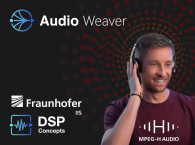
The popularity of OTT video (over-the-top) is growing rapidly and streaming media consumption is increasing across multiple devices, including smartphones, Smart TVs, and game consoles. Over the past few years, streaming media companies have prioritized the seamless transmission of high quality video and music, and improved user experience. Audio quality and audio features have not received the same level of attention, resulting in inconsistencies in the listening experience across devices. Emerging audio technologies, such as G-Audio’s Sol Loudness SDK, help solving those challenges by smoothing variations in loudness and providing continuity of the perceived sound level between streaming content for end-users.
"At G-Audio Labs, we are dedicated to improving the end-user listening experience. Our loudness management solution addresses common subscriber complaints and solves for volume inconsistencies between content programming. A smoother audio experience leads to increased subscriber satisfaction and that leads to improved retention,” says Henney Oh, CEO and Co-founder of G-Audio Labs.
According to Alexis Macklin, Analyst at Greenlight Insights, “With 62% of U.S. adults streaming TV and movies each week, streaming services have revolutionized the way consumers listen to and watch media. Unfortunately, this mass appeal has yet to translate to consistent audio quality. The streaming market is set to be disrupted by new solutions focused on setting higher standards in streaming audio quality. Loudness management will be central to the features that creators and publishers will need to deliver as a growing number of consumers expect consistent audio quality across streaming platforms.”

Based in Berkeley, California, G-audio Labs is backed by investment from SoftBank Ventures, Capstone Partners, LB Investment, and Korea Investment Partners. G-Audio is already customizing solutions for forward-looking companies like Honda, Naver, and partners like Tiledmedia and NexStreaming. With seven audio Ph.Ds leading its R&D efforts, the G-Audio team has invented numerous patented technologies and excels in algorithm development with deep knowledge in acoustics, psychoacoustics, and signal processing. G-audio has made significant contributions to international audio standardizations, including the binaural rendering standard for MPEG-H 3D Audio. The company was the winner of the AMD Studios VR Awards 2017 Innovative VR Company of the Year, and maintains active membership in standard developing organizations including MPEG and 3GPP, G-Audio is building the next generation playground for audio innovation.
G-Audio Labs' co-founder and CEO Dr. Henney Oh, has more than 15 years of experience working with advanced audio technologies, and holds more than 1,000 worldwide patents, most of which are essential to internationally recognized audio standards. Dr. Ben Chon, the company's COO, holds over 15 years of experience developing audio signal processing algorithms customized for digital devices such as smartphones, televisions and home theaters. Dr. Ted Lee, its chief-technology officer (CTO) has been working for over a decade in the development of binaural technology, 3D audio, multichannel audio systems, and human-computer interaction. He co-invented and developed the MPEG-H 3D Audio Binaural Renderer that is an ISO/IEC international standard. Adam Levenson, G-Audio's VP of Business Development, was a former Senior Director of Activision, and worked previously in the interactive content industry, with more than 25 years of experience within the creative, technical, legal, and business aspects of audio production and technology.

G-Audio’s SDK product line includes spatial audio rendering for 360° video and loudness management for streaming media. Other loudness management software solutions today employ a legacy "file-based" approach, which is a pre-processing pipeline that destructively modifies the original content. The Sol Loudness SDK uses a server-client architecture in which the server-side performs loudness measurement and generates metadata that the client-side uses to normalize content to the target loudness setting. Advantages to the server-client solution include, (1) the opportunity to set loudness targets per platform, end-user device, or even listening environment, and (2) the original content is never modified, avoiding compression artifacts. Naver Corporation, a South Korea-based internet content service company, is one of the first companies to integrate the Sol Loudness SDK for their streaming media services.
For more information on G-Audio Labs audio technology solutions, visit www.gaudiolab.com






